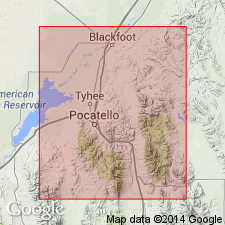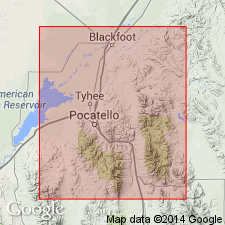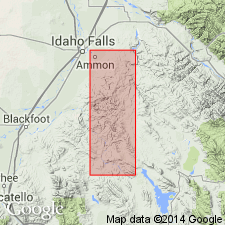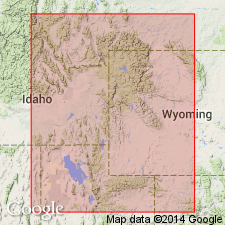
- Usage in publication:
-
- Portneuf limestone*
- Modifications:
-
- Areal extent
- AAPG geologic province:
-
- Snake River basin
Summary:
Pg. 492. Portneuf limestone of Thaynes group. Top formation of Thaynes group in Fort Hall Indian Reservation, southeastern Idaho. Thickness 1,500+/- feet. Overlies Fort Hall formation. [Age is Early Triassic.]
Source: US geologic names lexicon (USGS Bull. 896, p. 1710-1711).

- Usage in publication:
-
- Portneuf limestone*
- Modifications:
-
- [Principal reference]
- Biostratigraphic dating
- Dominant lithology:
-
- Limestone
- AAPG geologic province:
-
- Snake River basin
Summary:
Pg. 32, 38. Portneuf limestone of Thaynes group. Siliceous cherty gray to yellowish limestone in massive beds; rounded elongated nodules and streaks of chert. [Fossils (echinoids, bryozoans, crinoids, pelecypods, scaphopods, gastropods) identified by G.H. Girty, USGS, see p. 39-40.] Silicified fossils, including SPIRIFERINA n. sp.(?), TEREBRATULA SEMISIMPLEX, and other terebratuloids, and MYAPHORIA LINEATA(?), project from the weathered surfaces. Thickness 1,500+/- feet. Top formation of Thaynes group in Fort Hall Indian Reservation. Underlies Ankareh [now called Timothy] sandstone and overlies Fort Hall formation. Age is Early Triassic.
Named from Portneauf River, at head of which it is well exposed, [in T. 4 S., R. 38 E., Yandell Springs 15-min quadrangle], Bingham Co., Fort Hall Indian Reservation, southeastern ID.
Source: Publication; US geologic names lexicon (USGS Bull. 896, p. 1710-1711).

- Usage in publication:
-
- Portneuf limestone*
- Modifications:
-
- Areal extent
- AAPG geologic province:
-
- Snake River basin
Summary:
Pg. 17, 31-33, pl. 1. Portneuf limestone of Thaynes group. Unconformably underlies Timothy formation where mapped in Ammon and Paradise Valley quadrangles. In Lanes Creek, Freedom, and Montpelier quadrangles farther east and southeast, the limestone contains a well-developed red-bed unit, which consists of interbedded red sandstones and shales and ranges from 200 to 1,000 feet in thickness. [Age is Early Triassic.]
Source: US geologic names lexicon (USGS Bull. 1200, p. 3108).

- Usage in publication:
-
- Portneuf limestone member*
- Modifications:
-
- Revised
- AAPG geologic province:
-
- Snake River basin
- Wasatch uplift
Summary:
Pg. H-173, fig. 18. Portneuf limestone member of Thaynes formation. Described as member of Thaynes formation. Underlies Timothy sandstone member. [Age is Early Triassic.]
Source: US geologic names lexicon (USGS Bull. 1200, p. 3108).
For more information, please contact Nancy Stamm, Geologic Names Committee Secretary.
Asterisk (*) indicates published by U.S. Geological Survey authors.
"No current usage" (†) implies that a name has been abandoned or has fallen into disuse. Former usage and, if known, replacement name given in parentheses ( ).
Slash (/) indicates name conflicts with nomenclatural guidelines (CSN, 1933; ACSN, 1961, 1970; NACSN, 1983, 2005, 2021). May be explained within brackets ([ ]).

